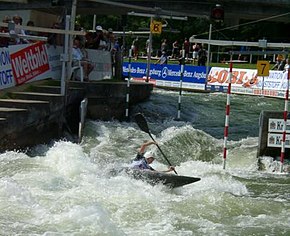Canoe slalom

Canoe slalom is a competitive discipline in canoeing . The aim is to drive a route determined by gates on fast flowing water in the shortest possible time without errors.
regulate
A stretch consists of a river section between 150 and 400 m long. 18-25 gates are distributed over the route, which must be passed according to their numbering. Most of the gates are green and white marked down gates. These are to be driven through in the direction of flow. 6 or 8 gates must be upward gates, which are marked red and white and must be crossed upstream. The gate posts must hang about 20 cm above the water surface.
The athlete must wear an approved swimming aid and approved, tightened head protection during the competition.
The total time of a run results from the total driving time plus any penalty times. To determine the overall result, the results of the two runs were added up until 2008; since 2009 only the better run has been included in the rating. There is only one run in the semifinals and finals.
2 penalty seconds are imposed for touching the goalpost; 50 penalty seconds for missing a goal. If an athlete enters a gate in the wrong direction of travel or drives keel up through a gate, 50 penalty seconds are also awarded if the gate is not correctly driven through again afterwards. If the driver has to leave the boat, the run will not be counted.
Boats
There are three boat classes in the canoe slalom:
| Boat class | Abbreviation | minimum length | minimum width | minimal weight |
|---|---|---|---|---|
| One kayak | K1 | 3.50 m | 60 cm | 9 kg |
| Canadians | C1 | 3.50 m | 60 cm | 9 kg |
| Two-man Canadians | C2 | 4.10 m | 75 cm | 15 kg |
The kayak is driven sitting down and steered with a double paddle. Canoe drivers kneel in their boat and steer it with a paddle. The boats are closed by spray covers that prevent water from entering.
Women’s and men’s races are now held in all boat classes. In addition, the two-man Canadians mixed in the program of the German championships; at the world championships, the C2 mixed, which was removed from the program there after 1981, will be back in 2017.
Competitions
In addition to the individual competitions, there are team races. A team consists of three boats of the same boat class that travel the route at the same time. The travel time is measured from the start of the first to the arrival of the last boat. The penalty seconds of each individual boat are added to the total time.
To increase the attractiveness of major events such as World Cups and championships, there is only a qualification with two runs. It is followed by a semi-final, which consists of only one run. The number of participants in the semi-finals varies depending on the boat class. The 10 fastest drivers of the semifinals drive the finals (1 run).
Competition venues
Canoe slalom was originally practiced on natural waters, but the trend is increasingly towards artificial whitewater systems . The most important routes in Germany are the Augsburger Eiskanal and the Markkleeberg Canoe Park .
history
The development of the folding kayak and its production on a large scale enabled the spread of kayaks on fast flowing waters in southern Germany, Austria and Switzerland. In the late 1920s and early 1930s, folding kayaks experienced a real boom. During this time the canoe slalom was born.
The first race that can be regarded as a preliminary form of the canoe slalom was held on Lake Hallwil in Switzerland. The stretch in the shape of an irregular star was marked with buoys . On October 8, 1932, the first race took place on a river near the Rupperswil weir on the Aare . Independent of the Swiss pioneers of the canoe slalom, the Austrian Willi Rabe had the same idea and organized a slalom for folding boat singles and doubles and kayaks on April 29, 1934 on the Traisen . In 1935 the first German slalom was held in Zwickau . Finally, in 1936, the slalom was recognized as a separate discipline by the International Canoeing Association (IRK), the predecessor organization of the International Canoeing Federation (ICF) . The Second World War meant that World Championships could only be held in Geneva in 1949 . For the time being, these took place every two years.
Until then, wooden canoes were used in addition to folding boats. From 1955, first Canadians, then plastic kayaks were used. In 1963, the last competition for folding kayaks was held at world championships, which were then completely replaced by boats made of plastic.
Canoe slalom was Olympic in 1972 and has been back in the Olympic program since 1992 . Today world championships are held annually except in the year of the Olympic Games.
Individual evidence
- ↑ Wolfram Steinwendtner: History of the Canoe Slalom 1933 - 2005 ( page no longer available , search in web archives ) Info: The link was automatically marked as defective. Please check the link according to the instructions and then remove this notice. . In: Österreichischer Kanu sport 2004, pp. 14–15





